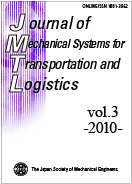Volume 3, Issue 2
Displaying 1-6 of 6 articles from this issue
- |<
- <
- 1
- >
- >|
Papers
-
2010 Volume 3 Issue 2 Pages 380-392
Published: 2010
Released on J-STAGE: April 14, 2010
Download PDF (637K) -
2010 Volume 3 Issue 2 Pages 393-404
Published: 2010
Released on J-STAGE: April 14, 2010
Download PDF (1319K) -
2010 Volume 3 Issue 2 Pages 405-414
Published: 2010
Released on J-STAGE: April 14, 2010
Download PDF (487K) -
2010 Volume 3 Issue 2 Pages 415-430
Published: 2010
Released on J-STAGE: April 16, 2010
Download PDF (1182K) -
2010 Volume 3 Issue 2 Pages 431-442
Published: 2010
Released on J-STAGE: May 25, 2010
Download PDF (631K) -
2010 Volume 3 Issue 2 Pages 443-456
Published: 2010
Released on J-STAGE: May 27, 2010
Download PDF (832K)
- |<
- <
- 1
- >
- >|
